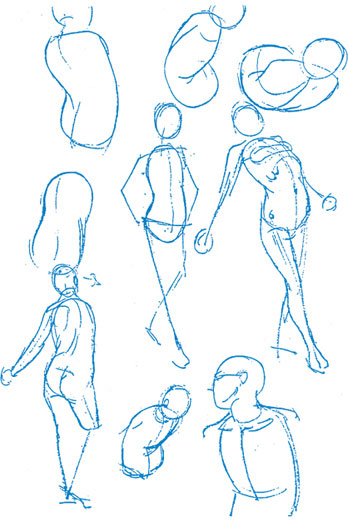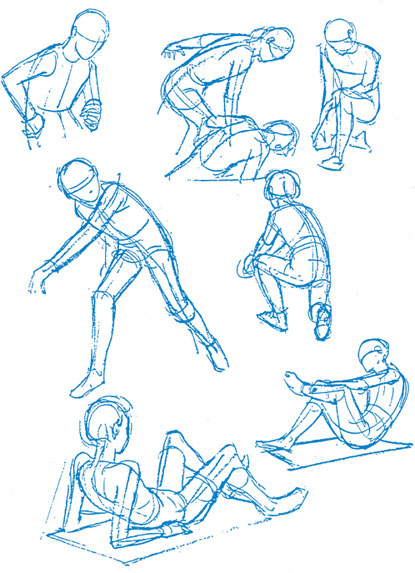Here is a sheet of figures drawn by Glenn Vilppu, life drawing instructor and layout man. This is an excellent simplistic approach to sketching the figure for animation purposes. I suggest you study them and for the purpose of the action analysis class tonight (and next week) try to emulate them. The model will be clothed but I am suggesting that you think of the structure and attitude of the body rather than the clothing. After capturing the pose begin to consider what affect that pose has on the costume. The idea is that you don’t animate clothing running around doing its thing — you animate a character which is a body that just happens to have some clothes on it.
If you want to experiment and use a cartoon character in place of the human figure that is fine. In any event try to caricaturize the pose, which means to go a little farther with the pose than the model has done (or even could do — not being a cartoon character).
If you’ve taken life drawing classes you are probably used to copying poses or attempting to locate the muscles and bones and depicting them as realistically as possible. But for the action study’s sake forget the muscles, forget the realism, and go for the action. I say action rather than pose because although we use poses in animation, every pose is in reality an action. No one ever just does nothing, especially in animation. If there is a pose it is either because something has just happened or is about to happen. If something funny has just happened give the audience an additional thrill by ending up with a funny pose. If something is about to happen, give the audience that superior feeling that they have figured out that something is about to happen. In true life the wheels of the mind turn undetected by observers, in cartoons that thinking process has to be caricatured. The story line takes care of a lot of that but the bulk of it is done visually. That is why we have such broad anticipations, “takes,” squashes and stretches, arcs, slow-ins and slow-outs, follow-throughs and overlaps, and long moving holds where you want to build up to some situation or let down from one — some pose you want to “milk” for all its worth.
So for the purposes of studying life drawing for animation, one pose does not tell enough, because seldom will the animator be faced with just a one-pose scene. So ideally there should be at least three poses to study and portray each action:
1. The Preparation: Telling the audience something is going to happen
2. The Anticipation: Gathering the forces to carry through with the action
3. The Action: Carrying out of the intended action. Plus, of course, all the follow-through, overlap, and resulting residuals such as dust, smoke; wind, destroyed property, chaos … whatever.


